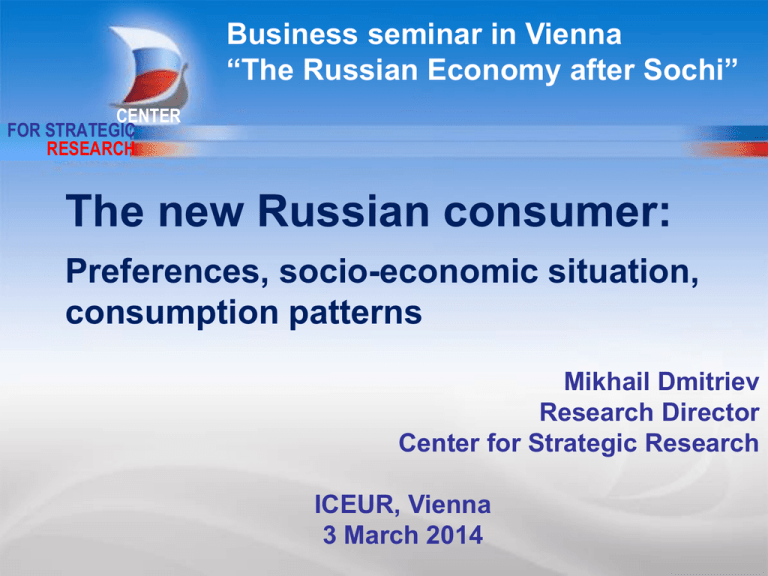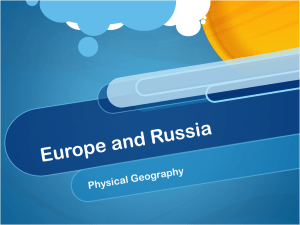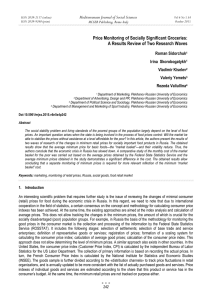***** 1
advertisement

Business seminar in Vienna “The Russian Economy after Sochi” CENTER FOR STRATEGIC RESEARCH The new Russian consumer: Preferences, socio-economic situation, consumption patterns Mikhail Dmitriev Research Director Center for Strategic Research ICEUR, Vienna 3 March 2014 Before the crisis: CENTER FOR STRATEGIC RESEARCH Demographic dividend and a positive global labor supply shock Share of the working-age population Advanced economies World Emerging markets 2 Source: City Research, Mckinsey Global Institute Drivers of pre-crisis acceleration CENTER FOR STRATEGIC RESEARCH Source: World Bank, IMF, WTO 3 Catching up with the OECD CENTER FOR STRATEGIC RESEARCH Source: WEF (2011). The Russia Global Competitiveness Report 2011, p.4 4 CENTER FOR STRATEGIC RESEARCH Wages were crowding out profits Gross profits and mixed income Wages (including shadow earnings and mixed income) Source: Rosstat, Gaidar Institute 5 CENTER FOR STRATEGIC RESEARCH Wages were crowding out Credit-driven consumer Credit-driven consumer boom profits boom Credit model of consumption Retail sales Real disposable income Source: Rosstat, CBR, Gaidar Institute Source: Rosstat, Gaidar Institute Outstanding loans to individuals, growth yoy 6 Success stories: Retail and hotels CENTER FOR STRATEGIC RESEARCH Share in GDP Growth of sales 2000=100 Russia Russia Austria Germany Germany UK Italy France UK France USA Japan Canada Source: MED 7 Success stories: Telecommunications CENTER FOR STRATEGIC RESEARCH Cell phone subscribers per 100 persons 2009 г. Russia Italy Germany Spain France USA Japan Source: MED 8 Success stories: Foreign tourism CENTER FOR STRATEGIC During last decade Russia rose from the 12th to the 7th place RESEARCH in the world in terms of tourist spending abroad Number of foreign tourist trips outside CIS, thousand 30000 25487 25000 18690 20000 15000 13147 14838 20464 30 23,8 20,9 20 15666 17,3 15 10 5000 5 0 0 2005 26,9 25 21641 10000 2004 Amount spend abroad, bln USD 2006 2007 2008 2009 2010 Source: UNWTO, Russian border authorities 8,8 2000 2005 2008 2009 2010 9 Car ownership Number of cars per 1000 inhabitants 10 Source^ the World Bank 10 Success stories: Financial penetration CENTER FOR STRATEGIC RESEARCH Share of banking account holders, percent 70 Number of ATM per 1000 persons 1 60 0.8 50 0.6 40 30 0.4 20 0.2 10 0 0 2007 Source: NISP, CSR 2010 2007 2010 11 The share of the middle class CENTER FOR STRATEGIC RESEARCH Source: Natalya Tikhonova 12 Middle class projections CENTER FOR STRATEGIC RESEARCH By 2020 middle class may comprise up to 50% of adult population and up to 70% of the population of the large cities Source: calculations by S.Misikhina 13 Income and employment growth CENTER FOR STRATEGIC RESEARCH • During 1999-2007 real disposable incomes real disposable incomes increased 2.4 times and real wages more than 3 times • Unemployment by ILO definition declined from 10.5% in 2000 to 5.1% in 2012 • Income inequality increased only marginally: in 10 years Gini increased – from 0.40 to 0.42) • Poverty headcount reduced by over 2.5 times and continued to decline during the first phase of the global financial crisis • Incomes were growing rather uniformly across various income groups, so the benefits of growth were spread broadly 14 Source: Rosstat POVERTY ALEVIATION CENTER FOR STRATEGIC RESEARCH • • • • • • In 2001 0.9% of Russians were living on 1.25 $US on PPP a day. Since 2008 this group is no longer observable in household surveys. 6% of Russians in 2006 were living on less than 2 $US on PPP a day. By 2009 there share declined more than 100 times – to just 0.05%. Practically all Russian poor now belong to the low middle class by the World Bank definition (daily incomes between 2 and 13 $US a day). Even if measured by the US poverty threshold (15.5 $US a day in 2010) Russian poverty headcount declined from 64.4% in 1999 to just 30.6% in 2010 15 Source: CSR, Russian Academy of National Economy and Civil Service Alleviation of absolute poverty CENTER FOR STRATEGIC RESEARCH Between 2001 and 2009 the share of Russians living for 2 $US a day on PPP declined more than 100 times from 5.97% to 0.05% 1 0,9 0,8 0,7 0,6 0,5 0,4 0,3 0,2 0,1 0 0,89 0,32 0,33 0,1 2001 2002 2003 2004 0,16 0,06 2005 2006 0,02 0 0 2007 2008 2009 16 Source: CSR, Russian Academy of National Economy and Civil Service Poverty in Russia and the USA CENTER FOR STRATEGIC RESEARCH In percent of the population Share of Russians which were poor are by the US poverty criteria: • In 1999 – 64.4% • In 2010 - 30,6% Russia (2012) USA (2010) Daily subsistence minimum (USD on PPP) 10,8 15,5 Share of population below subsistence minimum, % 12,6 15,1 17 17 CENTER FOR STRATEGIC RESEARCH Covergence in non-substantial consumption • Developing countries’ poverty crtiteria are no longer applicable to Russia • Being poor in Russia no longer means absolute deprivation. • Vast majority of Russian poor can afford a certain degree of non-substantial consumption • In many ways the gap between them and the middle class is shrinking. • In 2005-2010 the gap between 1-2nd and 5-9th income deciles declined • in car ownership from 2.5 times to 1.9 times • in computer ownership – from 3.3 to 1.5 times. 18 High mobility between income groups facilitates convergence CENTER FOR STRATEGIC RESEARCH 100% 80% 60% 40% 20% 0% 14,7 20,3 32,6 32,4 2,7 2,9 27 8,4 12,6 7,5 19,2 39 21,8 9,6 31,5 29,2 37,1 1,4 50,1 2 5,1 28,3 64,6 Periphery Non-poor, обобщенный периферия ниже среднего Periphery периферия низший класс Underclass Generalized of the non-middle of poverty средний класс middle средних бедности middle class class class noдвижения moves 1 group up нет вверх на 1 ступень 1 group down 2 groups up вниз на 1 ступень вверх на 2 ступени 2 groups down more than 2 чем groups up 19 вниз на 2 ступени вверх/вниз более на 2 ступени Source: NISP Nutritional convergence CENTER FOR STRATEGIC RESEARCH Nutrition gap between non-poor and poor 2000 2010 Vegetables 2,1 3,4 1,6 2,2 2,5 1,6 2,1 1,6 1,8 1,4 2,1 1,6 Calories per day 1,8 1,3 Proteins per day 1,9 1,4 Fruits and berries Meat and meat products Milk and milk products Eggs Fish and fish products Source: CSR, RANH I GS 20 Non-substantial consumption Cell phones per 100 households: CENTER Poor 244 FOR STRATEGIC RESEARCH Non-poor 225 10.7 Imported cars 17.2 28.7 Home made cars 23.6 14.5 LCD and Plasma TV 26.6 35.1 No-frost refrigerators 46.5 0 10 20 Poor Source: CSR, RANH I GS 30 Non-poor 40 50 21 The end of import- and credit-driven consumer boom is just behind the corner CENTER FOR STRATEGIC RESEARCH • Import-driven current consumption has already been close to saturation • Overconsumption of imported consumer goods and services has already contributed to ruble devaluation • Steady imports decline as a share of GDP will reduce incremental share of imports in consumption growth • Income growth, which was underpinning growth momentum until recently, has been stalled • Consumer credit boom also nearing the end: consumer debt servicing is already compatible with the volume of outstanding debt growth 22 Economic openness diminishes CENTER FOR STRATEGIC RESEARCH Bln $US % GDP 250 30 18 2.5 16 25 200 2 14 20 12 1.5 150 10 15 8 1 100 10 6 4 50 5 0.5 2 0 0 0 0 2001 2002 2003 2004 2005 2006 2007 2008 2009 2010 2011 2012 2013 Торговый баланс Trade balance Валовые ПИИ(RHS) (Правая ось) Gross FDI Платежный баланс Current account * Est. Торговый баланс Trade balance Gross FDI (RHS) Валовые ПИИ (Правая ось) Платежный баланс Current account 23 Source: Ren-Cap NES Macro Monitor CENTER FOR STRATEGIC RESEARCH 35 30 …but foreign debt dependency increases 600 800 35 700 30 500 600 25 25 400 500 20 20 400 15 300 300 15 200 10 200 10 100 5 0 0 100 5 0 0 Gross foreign debt, end-year, blnгода, $US (LHS) Валовый внешний долг (конец млрд долл США, левая шкала) Экспорт ВВП) Export, (% % GDP Экспорт (млрд долл Export, blnСША, $USправая (RHS) шкала) * Est. Foreign debt payments, in percent of export Расходы по обслуживанию внешнего долга (% экспорта) 24 Источник: Ren-Cap NES Macro Monitor CENTER FOR STRATEGIC RESEARCH Non-food consumption dominated in retail sales But now it comes to a halt 25 CENTER FOR STRATEGIC RESEARCH • • The next big things: non-tradables Instead, consumption growth is likely to be focused on non-tradables: • housing • education • health; • infrastructure services (particularly in the public utilities sector). Housing will be the most important of them all 26 Incomes were a priority issue in early 2000-s People’s “mandate" to Putin, 2002 33 Rise the living standards and resolve social problems 25 Improve the effectiveness of public management 16 Stimulate economic growth and employment 5 Address problems of culture, science, health and education Address problems of housing and utilities 2 Put an end to Chechen war 2 Restore Russia's might 1 Personal wishes 1 26 No answer, irrelevant answer Source: FOM 0 10 20 30 27 27 40 Ongoing increase in ut ilit y prices 94 Bad solut ions t o t he housing problem 81 Collapse of t he economy and agricult ure 75 Ev er- last ing t alk about ant icorrupt ion campaign wit h no real act ion t aken 70 Seeking t o ret ain t heir power in any way possible 67 Seeking t o get ev eryt hing f or t hemselv es and t heir relat iv es, clan syst em 66 Int roduct ion of Unif ied St at e Examinat ion 64 Inabilit y t o improv e t he enf orcement of law and order in t he count ry CENTER FOR STRATEGIC RESEARCH 62 Poor f ollow- up of decision implement at ion 62 Act iv e only during elect ions 60 Seeking benef it s only f or t hemselv es 58 Reduced number of gov ernment - paid univ ersit y st udent s 58 Disrespect f or t heir own count ry laws 57 Transf erring t heir money abroad 56 Inef f icient social policy 53 Improper police act ions 53 Endarkenment of t he people 52 Alienat ion f rom t he people 51 No care f or t he old people 49 Robbing t he people 48 The f act t hat civ il serv ant s are bet t er of f t han ent repreneurs 48 Uncert aint y of t he f ut ure 48 Good at st ealing and paying t o remain in power 48 Beadledom 47 Enslav ing t erms of mort gage lending 46 The f act t hat t his policy is only benef icial f or t he rich 46 Demagogy, only slogans and promises 46 Longing t o enj oy a bet t er lif e t han common people, caring f or t hemselv es only 45 The f act t hat Russia is giv en a raw- export s role in t he world 43 Only good at promot ing t heir own image 42 Inef f icient economic policy 42 Creat ing lif e condit ions t hat make people t hink how t o let t heir f lat in Russia 41 Ongoing inf lat ion in t he count ry t hat eat s up pensions and wages, and child benef it s 40 Longing t o make a prof it f or t hemselv es, and f or t his purpose making deals wit h anybody 39 Ev er- last ing lies 36 Inabilit y t o build a prof essional army, weak army 35 M anagerial incompet ence – unprof essionalism 33 Irresponsibilit y, hollow promises 29 Do not know what needs t o be done 28 The f act t hat democracy in t he count ry is in danger as shown by t he lat est elect ions 22 Prowest ern v iews Source: CSR 22 Ignorance of t he hist ory and cult ure of t heir own people Source: CSR Housing became a top priority in 2012 21 Conf used 28 15 Eart hliness 13 0 10 20 30 40 50 60 70 80 90 100 Housing convergence CENTER FOR STRATEGIC RESEARCH Poor Share of households living in separate dwelling, % Non-poor 97,7 98,7 Number of rooms per household 2,58 2,44 Total area, sq m 15,7 22,1 Source: CSR, RANH I GS 29 Housing stock dynamics • During 1980s housing stock increased by more than 30% • During the crisis of 1990s the growth slowed down by the factor of 2 • During successful 2000s it grew by only 14% - less than during the previous decade Mln sq m 3500 3000 2500 2000 1500 1000 500 0 1980 1990 1995 2000 2001 2002 2003 2004 2005 2006 2007 2008 2009 total (млн.кв.м.) Всего Source: Rosstat individual ownership ВInсобственности граждан (млн.кв.м.) 30 30 Mortgage lending is underdeveloped • Due to high growth of consumer lending current consumption was increasing faster than incomes • Share of consumer loans in total lending to individuals neared 50%, against 20% which is typical to EU • On the contrary, by the size of the mortgage market Russia is lagging behind. • Mortgages were stimulating purchases on the secondary market but discouraged housing construction Russia Austria Germany France Turkey Hungary 31 Source:Trust-Bank % of loan portfolio 31 Accessibility index of housing with loans 120 CENTER FOR STRATEGIC RESEARCH 100 80 60 40 20 0 1998 1999 2000 Russia 2001 2002 Moscow 2003 2004 2005 Moscow region 2006 2007 2008 2009 Saint-Petersburg 32 Source: CSR High housing ownership ratio may be an obstacle CENTER FOR STRATEGIC 120 RESEARCH Luxemburg Norway Per capita GDP, 1000 $US 100 Switzerland 80 60 40 Russia 20 0 40 50 60 70 Share of housing owners, % 80 90 100 CENTER FOR STRATEGIC RESEARCH First and second baby-boom generations will determine consumption patterns until the middle of this century Age Share of working-age population 66.000% 0-9 Second babyboom generation 64.000% 62.000% 60.000% 10-19 20-29 30-39 40-49 58.000% 50-59 56.000% 60-69 54.000% 70-79 52.000% 80-89 50.000% 90-99 >100 2030 2028 2026 2024 2022 2020 2018 2016 2014 2012 2010 2008 2006 2004 2002 2000 1998 1996 1994 1992 1990 48.000% Total 34 Source: Rosstat, Center for Strategic Research Uneven impact on unemployment CENTER FOR STRATEGIC RESEARCH • 2/3 of unemployment increase in advanced economies was delivered by the US and Spain • 60% of increase in the number of unemployed in emerging markets was generated by China and Russia 35 Source: ILO, IMF Global demographic turnaround CENTER FOR STRATEGIC RESEARCH • In 2013 the share of working-age population in the world population began to decline after a long period of fast continuous growth • The end of demographic dividend directly affects all major regions but South Asia and Africa • China’s share of working-age population will decline in the next two decades almost as fast as that of Japan during 1990-2010 • Global labor supply is facing long-term slowdown • Future economic growth will be overshadowed by the 36 negative labor supply shock The end of global demographic dividend: the share of working age population declines CENTER FOR STRATEGIC RESEARCH 37 Source: City Research Economic and labor market implications CENTER FOR STRATEGIC RESEARCH • Labor force decline will increase global returns on labor versus returns on capital • Average long-term wage growth may exceed growth of GDP per capita • Fast decline of labor supply will drive up China’s labor costs faster than ever, limiting export-led manufacturing growth and reducing trade surplus • Growing domestic consumption will suppress the investment rate and induce faster growth of services for domestic market • Working age population decline creates a powerful drag on productivity and economic growth • Shrinking labor force and growing labor costs in China and other emerging markets will ease pressure on employment in manufacturing and other tradables for the advanced economies • Domestic labor force decline and easing pressure from BRIC will accelerate wage growth in advanced economies • 38 Demographic turnaround will contain the rebound of pre-crisis imbalances One of economic implications: global drag on productivity growth CENTER FOR STRATEGIC RESEARCH • 1% decline in the share of working-age population was associated with productivity growth decline of 1.752.75% • China’s demographic supply shock implies that its average GDP growth for the next 20 years will stay below 6% 39 Source: City Research Change in real GDP growth rates: 2012-13 (percentage point) CENTER FOR STRATEGIC RESEARCH Russia: double labor supply shock Double labor supply shock: • Very fast decline of the working age population • Numerous and well-educated second baby-boomer generation entering labor market Labor market outcomes: • Slow economic growth and productivity growth • Declining labor force (- 630,000 in 1Q-3Q 2013) • Net job destruction (- 780,000 in 1Q-3Q 2013) • High labor participation rate • Very low unemployment (5.3-5.6%) close to 20-year minimum • Very high youth unemployment (15.8 % in mid 2012 – 4 times higher than in the 30-49 years old age group) • Wages growth (5.6% 1H 2013) - much faster than GDP (below 1.5%401H 2013) – at the expense of declining profits Medium-term forecast (before the Ukranian crisis) CENTER FOR STRATEGIC RESEARCH 2010 2011 2012 2013 2014 2015 2016 GDP Final consumption Household consumption Government consumption Gross investments Export Import 41 Source: Gaidar Institute CENTER FOR STRATEGIC RESEARCH Thank you for attention! 42










